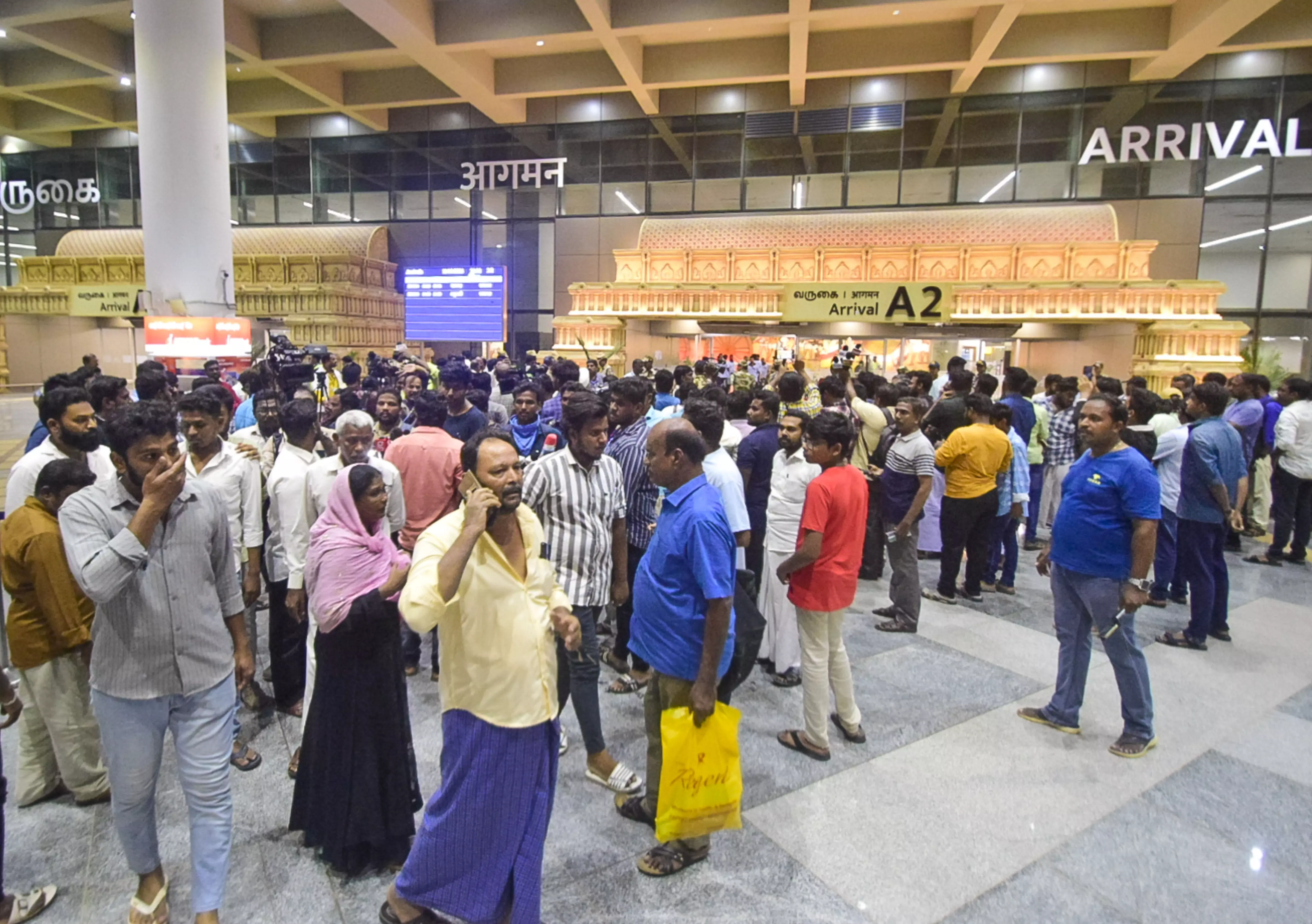JUST SPAMMING | Where danger lurks on the ground, air and rails

Passengers at the Trichy Airport after an Air India flight landed safely following a mid-air glitch (PTI)
It was a week of disasters that betrayed our gross inability to learn lessons from past catastrophes. Starting from the deaths of Sunday when the Indian Air Force put on display its prowess and possessions over the Marina sands to the Friday’s hovering of an Air India Express flight over Tiruchi for over two hours to that night’s ramming of the Bagmati Express from Mysuru to Darbhanga into a stationary goods train at Kavaraipettai station near Chennai, the week brought collective grief in succession.
As Congress leader Rahul Gandhi said in his X Page the accident at Kavaraipettai mirrored the 2023 rail mishap at Balasore in Odisha. ‘Accountability starts at the top. How many more families must be destroyed before this government wakes up?,’ he said. Many other ordinary people asked what happened to Kavach 4.0, which is an automatic train protection system. Since Union Railway Minister Ashwini Vaishnaw travelled on a train fitted with the safety system very recently under the glare of media spotlight, people remembered it and asked why it was not fitted to the ill-fated Bagmati Express.
News of that accident came in when the people of the State were just heaving a sigh of relief over the safe landing of the Air India Express flight that developed a technical snag after it took off from Tiruchi at 5.40 pm for Sharjah. That aborted flight with 141 persons onboard kept everyone on tenterhooks as it hovered over Tiruchi for over two hours before touching down at 8.20 pm, dominating prime time news, keeping various agencies on their toes and the people and passengers’ loved ones in deep anxiety. Relatives and friends who had reached home after dropping passengers at the airport rushed back to watch with bated breath the plane going in circles above their head.
No one on the ground had a clue as to what would be the fate of the aircraft. The authorities, on their part, kept 18 fire tenders and 20 ambulances ready, anticipating an inferno. In fact the sight of a huge fleet of fire tenders and ambulances along the road outside the airport accentuated the fears of the common people who too started fearing that the aircraft might catch fire or explode when it touched down. The snag was detected after takeoff when the wheel carriage of the plane refused to retract. So the aircraft cannot continue its journey to Sharjah with the wheels jutting out. But will the wheels work and help in the safe taxiing of the aircraft if it were to return to the runway?
Since the pilots or anyone on the ground could not give a definite answer, they decided to follow the protocols for landing when the wheel carriage refused to come out, leaving open the only option of a belly landing. So, to burn the fuel in the aircraft, the plane was going in circles in the sky for over two hours when friends, relatives and others concerned about the welfare of the passengers went through hell. The drivers of the ambulances and fire tenders, however, readied themselves for a rescue operation and television news channels that had just started their usual political debates abandoned the scheduled programme and kept a vigil over the flight encircling Tiruchi.
But when a technical snag of that sort crops up soon after takeoff, one is tempted to ask: What kind of maintenance work was done in preparation of the international flight’s departure? How did the ground engineers miss noticing the faulty wheel carriage? Do we not have the men and machines to detect such flaws before takeoff? Perhaps, we will know that when the probe by aviation experts is carried out. But if it was due to some oversight that the snag was not detected while on the ground, will the incident be a lesson for our aviation industry? Going by the mess up at the Marina sands, when planes, most of them built for use in wars, went about their dedicated tasks without any hitch in the sky above, we look like slow learners. For, this is not the first time Chennai has proved that as a city it cannot handle large crowds, leave alone the fact it was the sweltering heat that killed five persons and sent about a 100 others to hospitals during the air show.
Many said that DMK MP Kanimozhi Karunanidhi was on spot when she put out a message on X saying ‘Unmanageable crowds should be avoided in the future.’ True, in the past, too, Chennai had choked when extraordinary crowds had gathered at the same place. Say, like the A R Rahman concert some time back. Even otherwise there have been several instances when the police have not only found it difficult to control crowds and floundered in managing them. But how did the authorities fail to calculate the quantity of water that would be required to quench the thirst of a 15 lakh crowd on Sunday. For, casualties apart, lakhs of people were traumatized by their search for a drop of water. A touching vignette, as witnessed by a journalist, was a man going to a liquor shop, as no other shop was open in the vicinity, to buy a bottle of water for his children but turned away by the salesman who needed to stock water for the tipplers who would come hours later in the evening.
As Congress leader Rahul Gandhi said in his X Page the accident at Kavaraipettai mirrored the 2023 rail mishap at Balasore in Odisha. ‘Accountability starts at the top. How many more families must be destroyed before this government wakes up?,’ he said. Many other ordinary people asked what happened to Kavach 4.0, which is an automatic train protection system. Since Union Railway Minister Ashwini Vaishnaw travelled on a train fitted with the safety system very recently under the glare of media spotlight, people remembered it and asked why it was not fitted to the ill-fated Bagmati Express.
News of that accident came in when the people of the State were just heaving a sigh of relief over the safe landing of the Air India Express flight that developed a technical snag after it took off from Tiruchi at 5.40 pm for Sharjah. That aborted flight with 141 persons onboard kept everyone on tenterhooks as it hovered over Tiruchi for over two hours before touching down at 8.20 pm, dominating prime time news, keeping various agencies on their toes and the people and passengers’ loved ones in deep anxiety. Relatives and friends who had reached home after dropping passengers at the airport rushed back to watch with bated breath the plane going in circles above their head.
No one on the ground had a clue as to what would be the fate of the aircraft. The authorities, on their part, kept 18 fire tenders and 20 ambulances ready, anticipating an inferno. In fact the sight of a huge fleet of fire tenders and ambulances along the road outside the airport accentuated the fears of the common people who too started fearing that the aircraft might catch fire or explode when it touched down. The snag was detected after takeoff when the wheel carriage of the plane refused to retract. So the aircraft cannot continue its journey to Sharjah with the wheels jutting out. But will the wheels work and help in the safe taxiing of the aircraft if it were to return to the runway?
Since the pilots or anyone on the ground could not give a definite answer, they decided to follow the protocols for landing when the wheel carriage refused to come out, leaving open the only option of a belly landing. So, to burn the fuel in the aircraft, the plane was going in circles in the sky for over two hours when friends, relatives and others concerned about the welfare of the passengers went through hell. The drivers of the ambulances and fire tenders, however, readied themselves for a rescue operation and television news channels that had just started their usual political debates abandoned the scheduled programme and kept a vigil over the flight encircling Tiruchi.
But when a technical snag of that sort crops up soon after takeoff, one is tempted to ask: What kind of maintenance work was done in preparation of the international flight’s departure? How did the ground engineers miss noticing the faulty wheel carriage? Do we not have the men and machines to detect such flaws before takeoff? Perhaps, we will know that when the probe by aviation experts is carried out. But if it was due to some oversight that the snag was not detected while on the ground, will the incident be a lesson for our aviation industry? Going by the mess up at the Marina sands, when planes, most of them built for use in wars, went about their dedicated tasks without any hitch in the sky above, we look like slow learners. For, this is not the first time Chennai has proved that as a city it cannot handle large crowds, leave alone the fact it was the sweltering heat that killed five persons and sent about a 100 others to hospitals during the air show.
Many said that DMK MP Kanimozhi Karunanidhi was on spot when she put out a message on X saying ‘Unmanageable crowds should be avoided in the future.’ True, in the past, too, Chennai had choked when extraordinary crowds had gathered at the same place. Say, like the A R Rahman concert some time back. Even otherwise there have been several instances when the police have not only found it difficult to control crowds and floundered in managing them. But how did the authorities fail to calculate the quantity of water that would be required to quench the thirst of a 15 lakh crowd on Sunday. For, casualties apart, lakhs of people were traumatized by their search for a drop of water. A touching vignette, as witnessed by a journalist, was a man going to a liquor shop, as no other shop was open in the vicinity, to buy a bottle of water for his children but turned away by the salesman who needed to stock water for the tipplers who would come hours later in the evening.
( Source : Deccan Chronicle )
Next Story

